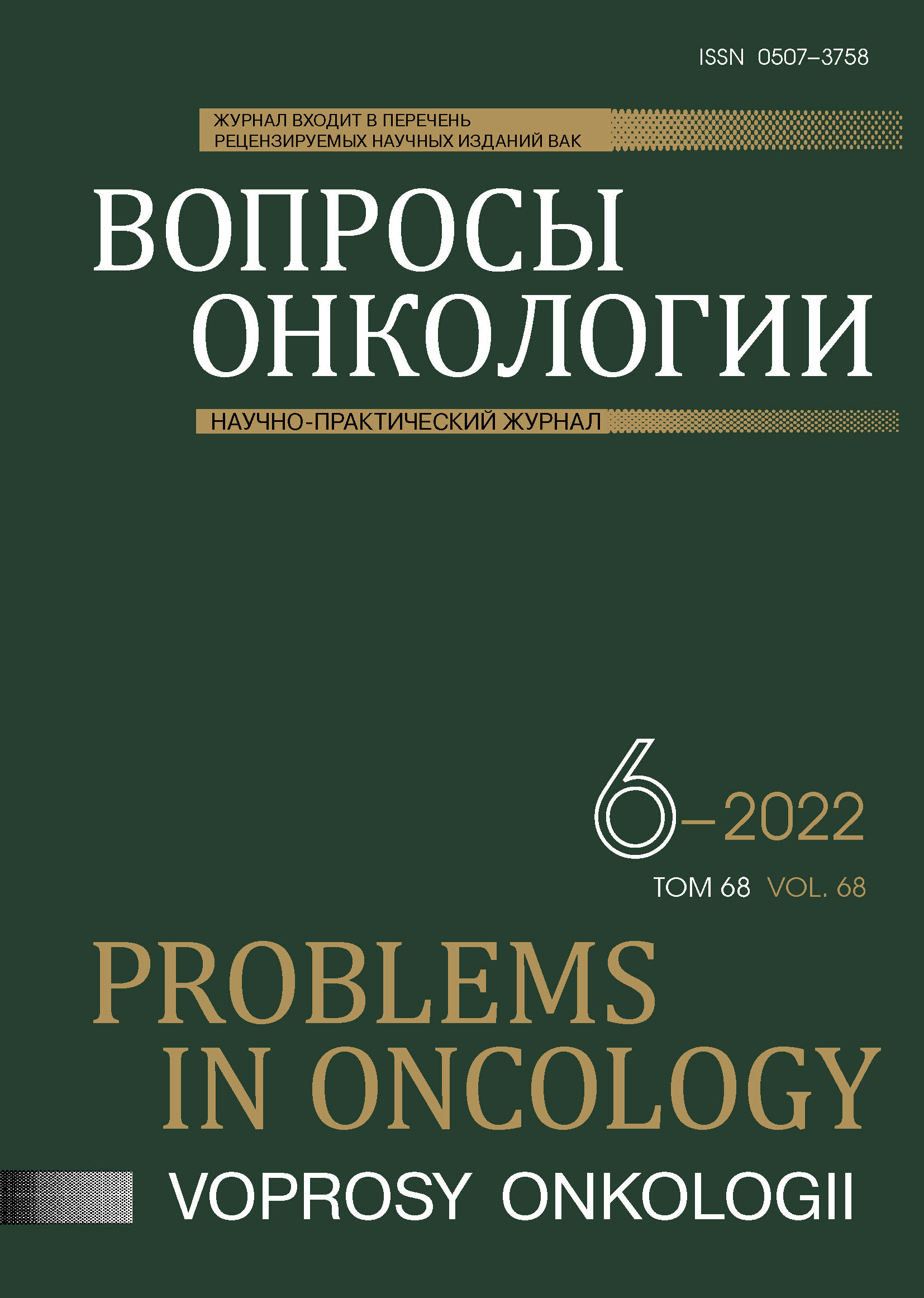Аннотация
В работе представлены результаты разработки малоинвазивного метода дифференциальной диагностики колоректального рака (КРР) и полипоза на основе анализа транкриптома клеток периферической крови.
Цель исследования. Определение профилей экспрессии отобранных по данным литературы генов, в клетках лейкоцитарной фракции (ЛФ) периферической крови у пациентов с КРР и полипами нижних отделов желудочно-кишечного тракта (ЖКТ), и создание на основе этого прогностической модели, позволяющей дифференцированно диагностировать КРР и полипоз.
Материал и методы. В исследование были включены образцы периферической крови пациентов с диагнозами КРР (n=33) и полипоз (n=22), а также контрольной группы пациентов (n=30). Выделенную из ЛФ РНК использовали для изготовления библиотек с помощью набора RNAHyperPrep&HyperCap (Roche NimbleGen, США) с двойным обогащением таргетными последовательностями. NGS осуществляли на аппарате MiSeq (Illumina, США). Количество прочтений, выровнявшихся с исследуемыми генами, принимали за оценку уровня экспрессии.
Результаты. Были выделены группы генов, дифференциально экспрессирующихся у пациентов с диагнозами КРР и полипоз и в контроле и построены модели логистической регрессии, позволяющие осуществить диагностику КРР, на основании анализа экспрессии генов FRMD3, ANXA3, DPEP1, CPEB4, MMD и TLR1 (точность 93,7%), и полипоза, на основании анализа экспрессии SERPINB5, CEACAM5, DPEP1 и STC1 (точность 84,6%) при сравнении с контрольной группой и отличить пациентов с диагнозом КРР от пациентов с диагнозом полипоз на основании анализа экспрессии генов MMD и MDM2 с точностью 78,3%.
Заключение. В дальнейшем необходимо исследование экспрессии генов с наибольшим диагностическим потенциалом у пациентов независимой выборки методом цифровой ОТ-ПЦР и уточнение созданных нами моделей.
Библиографические ссылки
Liew CC, Ma J, Tang HC et al. Peripheral blood transcriptome dynamically reflects system wide biology: a potential diagnostic tool // J Lab Clin Med. 2006;147(3):126–132. doi:10.1016/j.lab.2005.10.005
Marshall KW, Mohr S, El Khettabi F et al. A blood‐based biomarker panel for stratifying current risk for colorectal cancer // Int J Cancer. 2010;126(5):1177–1186. doi:10.1002/ijc.24910
Chang Y-T, Huang C-S, Yao C-T et al. Gene expression profile of peripheral blood in colorectal cancer // World J Gastroenterol. 2014;20(39):14463–14471. doi:10.3748/wjg.v20.i39.14463
Han M, Liew CT, Zhanget HW et al. Novel blood-based, five-gene biomarker set for the detection of colorectal cancer // Clin Cancer Res. 2008;14(2):455–460. doi:10.1158/1078-0432.CCR-07-1801
Xu Y, Xu Q, Yang L et al. Gene expression analysis of peripheral blood cells reveals toll-like receptor pathway deregulation in colorectal cancer // PloS One. 2013;8(5):e62870. doi:10.1371/journal.pone.0062870
Tsouma A, Aggeli C, Lembessis P et al. Multiplex RT-PCR-based detections of CEA, CK20 and EGFR in colorectal cancer patients // World J Gastroenterol. 2010;16(47):5965–5974. doi:10.3748/wjg.v16.i47.5965
Findeisen P, Röckel M, Nees M et al. Systematic identification and validation of candidate genes for detection of circulating tumor cells in peripheral blood specimens of colorectal cancer patients // Int J Oncol. 2008;33(5):1001–1010. doi:10.3892/ijo_00000088
Eisenach PA, Soeth E, Röder C et al. Dipeptidase 1 (DPEP1) is a marker for the transition from low-grade to high-grade intraepithelial neoplasia and an adverse prognostic factor in colorectal cancer // Br. J. Cancer. 2013;109(3):694–703. doi:10.1038/bjc.2013.363
Liu Q, Deng J, Yang C et al. DPEP1 promotes the proliferation of colon cancer cells via the DPEP1/MYC feedback loop regulation // Biochem Biophys Res Commun. 2020;532(4):520–527. doi:10.1016/j.bbrc.2020.08.063
Toiyama Y, Inoue Y, Yasuda H et al. DPEP1, expressed in the early stages of colon carcinogenesis, affects cancer cell invasiveness // J Gastroenterol. 2011;46(2):153–163. doi:10.1007/s00535-010-0318-1
Gao Y, Zens P, Su M et al. Chemotherapy-induced CDA expression renders resistant non-small cell lung cancer cells sensitive to 5′-deoxy-5-fluorocytidine (5′-DFCR) // J Exp Clin Cancer Res. 2021;40:138. doi:10.1186/s13046-021-01938-2
Wentzensen N, Wilz B, Findeisen P et al. Identification of differentially expressed genes in colorectal adenoma compared to normal tissue by suppression subtractive hybridization // Int J Oncol. 2004;24(4):987–994. doi:10.3892/ijo.24.4.987
Williet N, Petcu CA, Rinaldi L et al. The level of epidermal growth factor receptors expression is correlated with the advancement of colorectal adenoma: validation of a surface biomarker // Oncotarget. 2017;8(10):16507–16517. doi:10.18632/oncotarget.14961
Zheng H, Tsuneyama K, Cheng C et al. Maspin expression was involved in colorectal adenoma-adenocarcinoma sequence and liver metastasis of tumors // Anticancer Res. 2007;27(1A):259–265.
Chan CHF, Stanners CP. Recent advances in the tumour biology of the GPI-anchored carcinoembryonic antigen family members CEACAM5 and CEACAM6 // Curr Oncol. 2020;14(2):70–73. doi:10.3747/co.2007.109
Du K, Ren J, Fu Z et al. ANXA3 is upregulated by hypoxia-inducible factor 1-alpha and promotes colon cancer growth // Transl Cancer Res. 2020;9(12):7440–7449. doi:10.21037/tcr-20-994
Zhang C, Zhao Z, Liu H et al. Weighted gene co-expression network analysis identified a novel thirteen-gene signature associated with progression, prognosis, and immune microenvironment of colon adenocarcinoma patients // Front Genet. 2021;12:657658. doi:10.3389/fgene.2021.657658
Rehli M, Krause SW, Schwarzfischer L et al. Molecular cloning of a novel macrophage maturation-associated transcript encoding a protein with several potential transmembrane domains // Biochem Biophys Res Commun. 1995;217(2):661–667. doi:10.1006/bbrc.1995.2825
Urban-Wojciuk Z, Khan MM, Oyler BL et al. The role of TLRs in anti-cancer immunity and tumor rejection // Front Immunol. 2019;10:2388. doi:10.3389/fimmu.2019.02388
Söylemez Z, Arıkan ES, Solak M et al. Investigation of the expression levels of CPEB4, APC, TRIP13, EIF2S3, EIF4A1, IFNg, PIK3CA and CTNNB1 genes in different stage colorectal tumors // Turk J Med Sci. 2021;51(2):661–674 doi:10.3906/sag-2010-18
Zhao F, Yang G, Feng M et al. Expression, function and clinical application of stanniocalcin-1 in cancer // J Cell Mol Med. 2020;24(14):7686–7696 doi:10.1111/jcmm.15348
Hou H, Sun D, Zhang X. The role of MDM2 amplification and overexpression in therapeutic resistance of malignant tumors // Cancer Cell Int. 2019;19:216. doi: 10.1186/s12935-019-0937-4

Это произведение доступно по лицензии Creative Commons «Attribution-NonCommercial-NoDerivatives» («Атрибуция — Некоммерческое использование — Без производных произведений») 4.0 Всемирная.
© АННМО «Вопросы онкологии», Copyright (c) 2022
